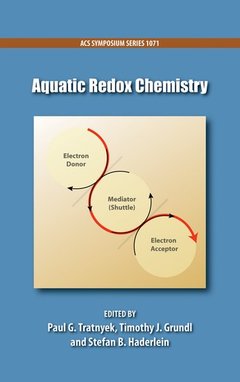Description
Aquatic Redox Chemistry
ACS Symposium Series, Vol. 1071
Coordinators: Tratnyek Paul, Grundl Timothy, Haderlein Stefan
Language: English
Subjects for Aquatic Redox Chemistry:
Publication date: 06-2012
632 p. · 15.9x23.2 cm · Hardback
632 p. · 15.9x23.2 cm · Hardback
Description
/li>Contents
/li>Biography
/li>
Oxidation-reduction (redox) reactions are among the most important and interesting chemical reactions that occur in aquatic environmental systems, which include soils, sediments, aquifers, rivers, lakes, estuaries, water treatment and distribution systems, etc. This volume provides a comprehensive overview of aquatic redox chemistry through chapters contributed by many of the leading investigators in the field. Each chapter summarizes core concepts and reports important new developments in areas of priority or emerging interest, such as the prediction of redox reaction rates and mechanisms, role of redox shuttles in biogeochemistry, interfacial properties of redox active minerals, role of reactive oxygen species in sunlit surface waters, water treatment technologies based on oxidation or reduction, and coupling of redox with transport processes. Fundamental and advanced aspects of each topic are balanced such that the volume can serve as teaching material for upper level students in environmental science or engineering, as well as being a valuable resource for experienced scientists and practitioners.
Preface. 1. Introduction to Aquatic Redox Chemistry. Timothy J. Grundl, Stefan Haderlein, James T. Nurmi, and Paul G. Tratnyek. 2. Thermodynamic Redox Calculations for One and Two Electron Transfer Steps: Implications for Halide Oxidation and Halogen Environmental Cycling. George W. Luther, III. 3. One-Electron Reduction Potentials from Chemical Structure Theory Calculations. Eric J. Bylaska, Alexandra J. Salter-Blanc, and Paul G. Tratnyek. 4. Thermodynamic Control on Terminal Electron Transfer and Methanogenesis. Christian Blodau. 5. Redox Chemistry and Natural Organic Matter (NOM): Geochemists' Dream, Analytical Chemistsagt,' Nightmare. Donald L. Macalady and Katherine Walton-Day. 6. Electron Shuttling by Natural Organic Matter: Twenty Years After. Garrison Sposito. 7. Electrochemistry of Natural Organic Matter. James T. Nurmi and Paul G. Tratnyek. 8. Pathways Contributing to the Formation and Decay of Ferrous Iron in Sunlit Natural Waters. Shikha Garg, Andrew L. Rose, and T. David Waite. 9. The Role of Iron Coordination in the Production of Reactive Oxidants from Ferrous Iron Oxidation by Oxygen and Hydrogen Peroxide. Christina Keenan Remucal and David L. Sedlak. 10. TiO2 Photocatalysis for the Redox Conversion of Aquatic Pollutants. Jaesang Lee, Jungwon Kim, and Wonyong Choi. 11. Chlorine Based Oxidants for Water Purification and Disinfection. Gregory V. Korshin. 12. Remediation of Chemically-Contaminated Waters Using Sulfate Radical Reactions: Kinetic Studies. Stephen P. Mezyk, Kimberly A. Rickman, Garrett McKay, Charlotte M. Hirsch, Xuexiang He, and Dionysios D. Dionysiou. 13. Voltammetry of Sulfide Nanoparticles and the FeS(aq) Problem. G. R. Helz, I. Ciglenecki, D. Krznaric, and E. Bura-Nakic. 14. Redox Reactivity of Organically Complexed Iron(II) Species with Aquatic Contaminants Timothy J. Strathmann. 15. Fe2+ Sorption at the Fe Oxide-Water Interface: A Revised Conceptual Framework. Christopher A. Gorski and Michelle M. Scherer. 16. Redox Driven Stable Isotope Fractionation. Jay R. Black, Jeffrey A. Crawford, Seth John, and Abby Kavner. 17. Redox Properties of Structural Fe in Smectite Clay Minerals. Anke Neumann, Michael Sander, and Thomas B. Hofstetter. 18. Reactivity of Zerovalent Metals in Aquatic Media: Effects of Organic Surface Coatings. Paul G. Tratnyek, Alexandra J. Salter-Blanc, James T. Nurmi, James E. Amonette, Juan Liu, Chongmin Wang, Alice Dohnalkova, and Donald R. Baer. 19. Current Perspectives on the Mechanisms of Chlorohydrocarbon Degradation in Subsurface Environments: Insight from Kinetics, Product Formation, Probe Molecules, and Isotope Fractionation. Martin Elsner and Thomas B. Hofstetter. 20. Degradation Routes of RDX in Various Redox Systems. Annamaria Halasz and Jalal Hawari. 21. Role of Coupled Redox Transformations in the Mobilization and Sequestration of Arsenic. Janet G. Hering, Stephan J. Hug, Claire Farnsworth, and Peggy A. Oagt,'Day. 22. Redox Processes Affecting the Speciation of Technetium, Uranium, Neptunium, and Plutonium in Aquatic and Terrestrial Environments. Edward J. O'Loughlin, Maxim I. Boyanov, Dionysios A. Antonopoulos, and Kenneth M. Kemner. 23. Rate Controlling Processes in the Transformation of Tetrachloroethylene and Carbon Tetrachloride under Iron Reducing and Sulfate Reducing Conditions. Elizabeth C. Butler, Yiran Dong, Lee R. Krumholz, Xiaoming Lian
Dr. Paul G. Tratnyek is currently Professor, and Associate Head, in the Division of Environmental and Biomolecular Systems (EBS), Institute of Environmental Health (formerly Oregon Graduate Institute, OGI), at the Oregon Health & Science University, Portland OR, USA. His research concerns oxidation-reduction reactions and other physico-chemical processes that control the fate and effects of environmental substances, including minerals, metals, organics, and nanoparticles. Dr. Timothy J. Grundl is currently Professor in the Geosciences Department and Chair in the School of Freshwater Sciences (formerly the Great Lakes WATER Institute) at the University of Wisconsin-Milwaukee, Milwaukee, WI, USA. His research uses environmental tracers in the study of oxidation-reduction reactions, groundwater provenance and recharge dynamics and fate of pollutants in aquifer systems. Dr. Stefan B. Haderlein is a full Professor at the Center for Applied Geosciences (ZAG) of the Eberhard-Karls University Tübingen, Germany. His research concerns sorption processes, oxidation-reduction reactions and other physico-chemical processes that control the fate of contaminants in the subsurface as well as stable isotope techniques to trace their origin and fate.
© 2024 LAVOISIER S.A.S.




